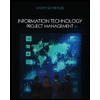
BUSINESS DRIVEN TECHNOLOGY(LL)-W/ACCESS
7th Edition
ISBN: 9781260149043
Author: BALTZAN
Publisher: MCGRAW-HILL HIGHER EDUCATION
expand_more
expand_more
format_list_bulleted
Question
Chapter 19, Problem 7AYK
Program Plan Intro
Business Requirements:
- The specific business requests system should meet so as to be successful.
- The entire system development effort is driven by business requirements.
- The business requirements are gathered through investigation.
- The users identify all business needs of organization and take measurements for these needs.
- The methods to gather requirements includes:
- Conducting user interviews to determine current issues and operations.
- Surveying employees through questionnaires for discovering issues.
- Making observations to determine manner in which current operations are been performed.
- Reviewing business documents for discovering policies, reports and how information is been used in organization.
Ambiguous Business Requirements:
- An ambiguous requirement means that multiple readers may interpret the same thing in different ways.
- It may rise due to inadequate participation of end users during design and analysis phases.
- It may occur commonly in reports due to different mindset of developers and users.
Expert Solution & Answer
Want to see the full answer?
Check out a sample textbook solution
Students have asked these similar questions
Hi, please solve this trying to follow this criteria. (use Keil)
Abstract describing the requirements and goals of the assignment.
List file with no errors or warnings.
Brief description of your implementation design and code.
Debugging screen shots for different scenarios with your reference and comments.
Conclusion
Can you solve using iterative expansion
using r language
Chapter 19 Solutions
BUSINESS DRIVEN TECHNOLOGY(LL)-W/ACCESS
Ch. 19 - What are the three interdependent variables...Ch. 19 - Prob. 2OCCh. 19 - Prob. 3OCCh. 19 - Prob. 1CQCh. 19 - Prob. 2CQCh. 19 - How could more time spent in the analysis and...Ch. 19 - Prob. 4CQCh. 19 - Prob. 1RQCh. 19 - Prob. 2RQCh. 19 - Prob. 3RQ
Ch. 19 - Prob. 4RQCh. 19 - Prob. 5RQCh. 19 - Prob. 6RQCh. 19 - Prob. 7RQCh. 19 - Prob. 8RQCh. 19 - Prob. 9RQCh. 19 - Prob. 1MBDCh. 19 - Prob. 2MBDCh. 19 - Prob. 3MBDCh. 19 - Prob. 4MBDCh. 19 - Prob. 5MBDCh. 19 - Prob. 6MBDCh. 19 - Prob. 1CCOCh. 19 - Prob. 2CCOCh. 19 - Prob. 3CCOCh. 19 - Prob. 4CCOCh. 19 - Prob. 5CCOCh. 19 - Prob. 1CCTCh. 19 - Prob. 2CCTCh. 19 - Prob. 3CCTCh. 19 - Prob. 4CCTCh. 19 - Prob. 5CCTCh. 19 - Prob. 1AYKCh. 19 - Prob. 2AYKCh. 19 - Prob. 3AYKCh. 19 - Prob. 4AYKCh. 19 - Prob. 5AYKCh. 19 - Prob. 6AYKCh. 19 - Prob. 7AYK
Knowledge Booster
Similar questions
- using r languagearrow_forwardCompute a Monte Carlo estimate of 0.8 by sampling from Uniform(0,0.8) and estimate the variance of ⑦.arrow_forwardWrite a C program using embedded assembler with a function to convert a digit (0 – 15) to the corresponding ASCII character representing the value in hexadecimal. For numbers 0 – 9, the output will be the characters '0' – '9', for numbers 10 – 15 the characters 'A' – 'F'. The entire core of the program must be written in symbolic instruction language; arrays may not be used. You may only use C to print the result. Tip: This piece of C program will do the same thing: character = number < 10 ? number + '0' : number + 55; As a basis, you can use this program again , which increments a variable. Just replace the INC instruction with ADD and add a test (CMP) with some conditional jump.arrow_forward
- Answer the question fully and accurately by providing the required files(Java Code, Two output files and written answers to questions 1-3 in a word document)meaning question 1 to 3 also provide correct answers for those questions.(note: this quetion is not graded).arrow_forward.NET Interactive Solving Sudoku using Grover's Algorithm We will now solve a simple problem using Grover's algorithm, for which we do not necessarily know the solution beforehand. Our problem is a 2x2 binary sudoku, which in our case has two simple rules: •No column may contain the same value twice •No row may contain the same value twice If we assign each square in our sudoku to a variable like so: 1 V V₁ V3 V2 we want our circuit to output a solution to this sudoku. Note that, while this approach of using Grover's algorithm to solve this problem is not practical (you can probably find the solution in your head!), the purpose of this example is to demonstrate the conversion of classical decision problems into oracles for Grover's algorithm. Turning the Problem into a Circuit We want to create an oracle that will help us solve this problem, and we will start by creating a circuit that identifies a correct solution, we simply need to create a classical function on a quantum circuit that…arrow_forward.NET Interactive Solving Sudoku using Grover's Algorithm We will now solve a simple problem using Grover's algorithm, for which we do not necessarily know the solution beforehand. Our problem is a 2x2 binary sudoku, which in our case has two simple rules: •No column may contain the same value twice •No row may contain the same value twice If we assign each square in our sudoku to a variable like so: 1 V V₁ V3 V2 we want our circuit to output a solution to this sudoku. Note that, while this approach of using Grover's algorithm to solve this problem is not practical (you can probably find the solution in your head!), the purpose of this example is to demonstrate the conversion of classical decision problems into oracles for Grover's algorithm. Turning the Problem into a Circuit We want to create an oracle that will help us solve this problem, and we will start by creating a circuit that identifies a correct solution, we simply need to create a classical function on a quantum circuit that…arrow_forward
arrow_back_ios
SEE MORE QUESTIONS
arrow_forward_ios
Recommended textbooks for you
 Management Of Information SecurityComputer ScienceISBN:9781337405713Author:WHITMAN, Michael.Publisher:Cengage Learning,
Management Of Information SecurityComputer ScienceISBN:9781337405713Author:WHITMAN, Michael.Publisher:Cengage Learning, Information Technology Project ManagementComputer ScienceISBN:9781285452340Author:Kathy SchwalbePublisher:Cengage Learning
Information Technology Project ManagementComputer ScienceISBN:9781285452340Author:Kathy SchwalbePublisher:Cengage Learning Information Technology Project ManagementComputer ScienceISBN:9781337101356Author:Kathy SchwalbePublisher:Cengage Learning
Information Technology Project ManagementComputer ScienceISBN:9781337101356Author:Kathy SchwalbePublisher:Cengage Learning Principles of Information Systems (MindTap Course...Computer ScienceISBN:9781305971776Author:Ralph Stair, George ReynoldsPublisher:Cengage Learning
Principles of Information Systems (MindTap Course...Computer ScienceISBN:9781305971776Author:Ralph Stair, George ReynoldsPublisher:Cengage Learning Principles of Information Systems (MindTap Course...Computer ScienceISBN:9781285867168Author:Ralph Stair, George ReynoldsPublisher:Cengage Learning
Principles of Information Systems (MindTap Course...Computer ScienceISBN:9781285867168Author:Ralph Stair, George ReynoldsPublisher:Cengage Learning Fundamentals of Information SystemsComputer ScienceISBN:9781305082168Author:Ralph Stair, George ReynoldsPublisher:Cengage Learning
Fundamentals of Information SystemsComputer ScienceISBN:9781305082168Author:Ralph Stair, George ReynoldsPublisher:Cengage Learning

Management Of Information Security
Computer Science
ISBN:9781337405713
Author:WHITMAN, Michael.
Publisher:Cengage Learning,

Information Technology Project Management
Computer Science
ISBN:9781285452340
Author:Kathy Schwalbe
Publisher:Cengage Learning

Information Technology Project Management
Computer Science
ISBN:9781337101356
Author:Kathy Schwalbe
Publisher:Cengage Learning

Principles of Information Systems (MindTap Course...
Computer Science
ISBN:9781305971776
Author:Ralph Stair, George Reynolds
Publisher:Cengage Learning

Principles of Information Systems (MindTap Course...
Computer Science
ISBN:9781285867168
Author:Ralph Stair, George Reynolds
Publisher:Cengage Learning

Fundamentals of Information Systems
Computer Science
ISBN:9781305082168
Author:Ralph Stair, George Reynolds
Publisher:Cengage Learning